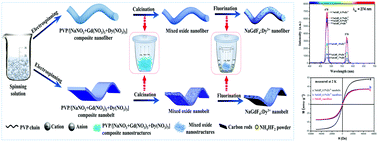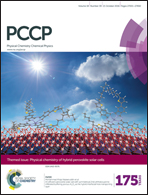NaGdF4:Dy3+ nanofibers and nanobelts: facile construction technique, structure and bifunctionality of luminescence and enhanced paramagnetic performances
Abstract
Luminescent-magnetic bifunctional NaGdF4:Dy3+ nanofibers and nanobelts have been successfully fabricated by a combination of electrospinning followed by subsequent calcination with fluorination technology for the first time. The structure, morphologies, and luminescence and magnetic properties of the synthesized materials have been investigated by a variety of techniques. X-ray diffraction (XRD) analysis shows that as-prepared NaGdF4:Dy3+ nanostructures are pure hexagonal structures. Scanning electron microscopy (SEM) observations indicate that directly electrospinning-made PVP/[NaNO3 + Gd(NO3)3 + Dy(NO3)3] composite nanofibers and nanobelts have smooth surfaces, good dispersion and uniform size, and surfaces of NaGdF4:Dy3+ nanofibers and nanobelts become rough after calcination and fluorination processes. The mean diameters of PVP/[NaNO3 + Gd(NO3)3 + Dy(NO3)3] composite nanofibers and NaGdF4:0.5%Dy3+ nanofibers are, respectively, 402.20 ± 2.39 nm and 246.06 ± 5.84 nm at the confidence level of 95%. The mean widths and thicknesses of PVP/[NaNO3 + Gd(NO3)3 + Dy(NO3)3] composite nanobelts and NaGdF4:0.5%Dy3+ nanobelts are 4.16 ± 0.17 μm and 279 nm, and 0.83 ± 0.01 μm and 130 nm, respectively. Under the excitation of 274 nm ultraviolet light, NaGdF4:Dy3+ nanofibers and nanobelts show the predominant blue and yellow emission peaks at 478 and 570 nm corresponding to the 4F9/2 → 6HJ/2 (J = 15, 13) energy level transitions of Dy3+ ions, respectively. NaGdF4:0.5%Dy3+ nanofibers have higher photoluminescence intensity than their nanobelt counterpart. In addition, all the NaGdF4:Dy3+ nanofibers and nanobelts display superparamagnetic properties. The NaGdF4:0.5%Dy3+ nanobelts show the highest magnetization, and NaGdF4:0.5%Dy3+ nanofibers have slightly higher magnetization values than NaGdF4 nanofibers. NaGdF4:Dy3+ nanofibers and nanobelts simultaneously possess excellent luminescence and enhanced superparamagnetic properties, which make them ideally suitable for application in many fields such as solid-state lasers, lighting and displays, and magnetic resonance imaging. The design conception and construction strategy developed in this work may provide some new guidance for the synthesis of other rare earth fluoride nanostructures with various morphologies.


 Please wait while we load your content...
Please wait while we load your content...